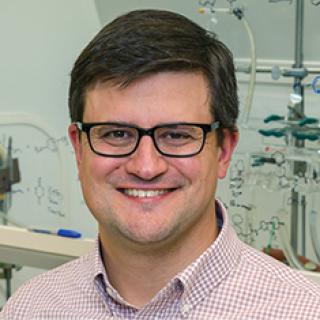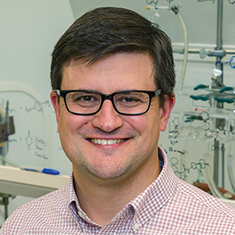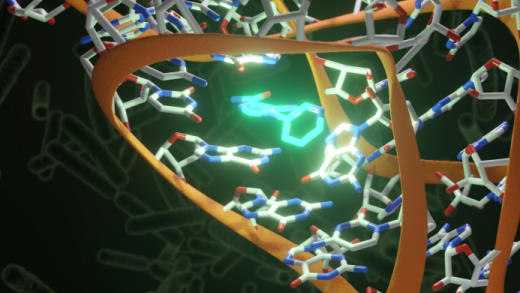
John 'Jay' Schneekloth, Jr., Ph.D.
- Center for Cancer Research
- National Cancer Institute
- Building 538, Room 240
- Frederick, MD 21702-1201
- 301-228-4620
- schneeklothjs@mail.nih.gov
RESEARCH SUMMARY
My laboratory uses chemical biology approaches to identify and study small molecules that bind to RNA.
Areas of Expertise

John 'Jay' Schneekloth, Jr., Ph.D.
Research
Targeting RNA with Druglike Small Molecules
The identification of selective RNA- and DNA-binding small molecules has been a longstanding challenge for chemical biology. Recent studies have demonstrated that while more than 85% of the human genome is transcribed into RNA, just 3% of those transcripts code for protein sequences. Coupled with the discovery that non-coding functions of RNA can drive disease, RNA has emerged as an intriguing but challenging therapeutic target for small molecules. In particular, regulatory nucleic acids that drive the expression of clinically important but so-called "undruggable" proteins such as c-MYC and KRAS respresent targets of interest. Our laboratory aims to advance the field of targeting RNA with druglike small molecules on multiple fronts. We use an integrated approach, including chemical biology, medicinal chemistry, structural biology, and functional genomics to understand and control RNA targets with small molecules. WIth respect to discovery, we have developed a small molecule microarray (SMM) high throughput screening platform that allows us to rapidly identify and profile the RNA-binding properties of small molecules. We use hits from this screening platform as the basis for development of small molecule probes that selectively target RNA. This work has led to the discovery that druglike compounds are suitable starting points for inhibitor discovery efforts for RNA targets, while driving fundamental advances in understanding RNA-small molecule recognition. Together, this work aims to develop RNA-binding small molecule probes to improve our understanding of RNA-mediated processes and disease states, particularly for cancers with no existing treatment options.
Publications
- Bibliography Link
- View Dr. Schneekloth's Complete Bibliography at NCBI.
Targeting Non-coding RNA Sensitizes Cancer Cells to Drugs
Synthetic ligands for PreQ1 riboswitches provide structural and mechanistic insights into targeting RNA tertiary structure
Targeting Mammalian Translational Inhibition with Tetracyclines
Chemical and structural studies provide a mechanistic basis for recognition of the MYC G-quadruplex
Characterization of clinically used oral antiseptics as quadruplex-binding ligands
Biography

John 'Jay' Schneekloth, Jr., Ph.D.
Dr. Schneekloth received his undergraduate degree from Dartmouth College in 2001 where he worked with Prof. Gordon Gribble. He then moved to Yale University and obtained a Ph.D. from the chemistry department with Prof. Craig Crews in 2006. As a graduate student he studied natural product total synthesis and developed the first cell-permeable PROTAC molecules. He then pursued an NIH postdoctoral fellowship with Prof. Erik Sorensen at Princeton University where he worked on the development of a new multicomponent reaction and the application of this reaction to the synthesis of analgesic natural products. He returned to Yale in 2009 where he worked as a medicinal chemist at the Yale Small Molecule Discovery Center. In 2011, Dr. Schneekloth joined NCI where his research involves using synthetic chemistry and high throughput chemical biology approaches to develop chemical probes of RNA, with a particular emphasis on targeting RNA with druglike small molecules.
Job Vacancies
We have no open positions in our group at this time, please check back later.
To see all available positions at CCR, take a look at our Careers page. You can also subscribe to receive CCR's latest job and training opportunities in your inbox.
Team
News
Covers

Parallel Discovery Strategies Provide a Basis for Riboswitch Ligand Design
The apple does not fall far from the tree. In this issue, Tran et al. describe synthetic small molecules that activate the ZTP riboswitch, a bacterial RNA that regulates gene expression. The apples signify RNA bound to particular synthetic ligands, with the best ligand being grasped by the researcher.
Parallel Discovery Strategies Provide a Basis for Riboswitch Ligand Design
Brandon Tran, Patricio Pichling, Logan Tenney, Colleen M. Connelly, Michelle H. Moon, Adrian R. Ferre´-D’Amare´ ,
John S. Schneekloth, Jr.* and Christopher P. Jones* in Cell Chemical Biology, 2020, 27, 1241–1249






